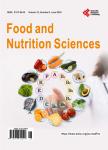Association between the Adherence to AHA Step 1 Nutrition Criteria and the Cardiometabolic Outcome in the General Population a Two Year Follow-Up Study
Association between the Adherence to AHA Step 1 Nutrition Criteria and the Cardiometabolic Outcome in the General Population a Two Year Follow-Up Study作者机构:Center for the Study of Atherosclerosis SISA Sez Reg Lomb Bassini Hospital Cinisello Balsamo Italy Center for the Study of Atherosclerosis SISA Sez Reg Lomb Bassini Hospital Cinisello Balsamo Italy 2Department of Phar- macological Sciences Università degli Studi di Milano Milan Italy Department of Phar- macological Sciences Università degli Studi di Milano Milan Italy I.R.C.C.S. Multimedica Milan Italy Department of Phar- macological Sciences Università degli Studi di Milano Milan Italy I.R.C.C.S. Multimedica Milan Italy.
出 版 物:《Food and Nutrition Sciences》 (食品与营养科学(英文))
年 卷 期:2012年第3卷第2期
页 面:274-280页
学科分类:1002[医学-临床医学] 100201[医学-内科学(含:心血管病、血液病、呼吸系病、消化系病、内分泌与代谢病、肾病、风湿病、传染病)] 10[医学]
主 题:AHA Step 1 MUFA PUFA Cholesterol
摘 要:Introduction: The National Cholesterol Education Program and the American Heart Association considered a dietary therapy as a primary approach to prevent and treat hyperlipemia and hypertension. Mediterranean diet has been promoted as a model of healthy eating and widely recognized for favorable effects on lipid profile. Objective: We investigated whether the adherence to dietary recommendations have any significant benefit on cardiovascular risk factors. A cohort of 2141 of subjects attending our center was recruited by collaborating General Practitioners who participate in the PLIC Study. Methods: Participants completed a week quantitative food questionnaire, which was analized on a subgroup of 338 subjects at enrolment (V1) and after two years of follow up (V2). Daily energy intake in Kcal, lipid, protein, carbohydrates in percentage of total energy, monounsatured (MUFA), saturated (SFA), polyunsaturated fatty acids (PUFA) in g/die, cholesterol in mg/die was calculated from the food questionnaires. Cardiovascular risk (CVR) was estimated according Framingham algorithm. Results: Subjects which adhered to AHA step 1 diet showed a significantly lower total cholesterol, 213.88 ± 43.00 vs 220.19 ± 39.3 mg/dL, LDL-cholesterol, 139.80 ± 76.36 vs 142.75 ± 35.60 mg/dL (p 0.01 for both) as compared to subjects with an impaired dietary pattern while no differences were observed for HDL cholesterol. Conclusions: Changes in dietary profiles are associated with an improved lipid profile and therefore remain one of the more favorable nutritional models in the primary prevention of cardiovascular disease.



